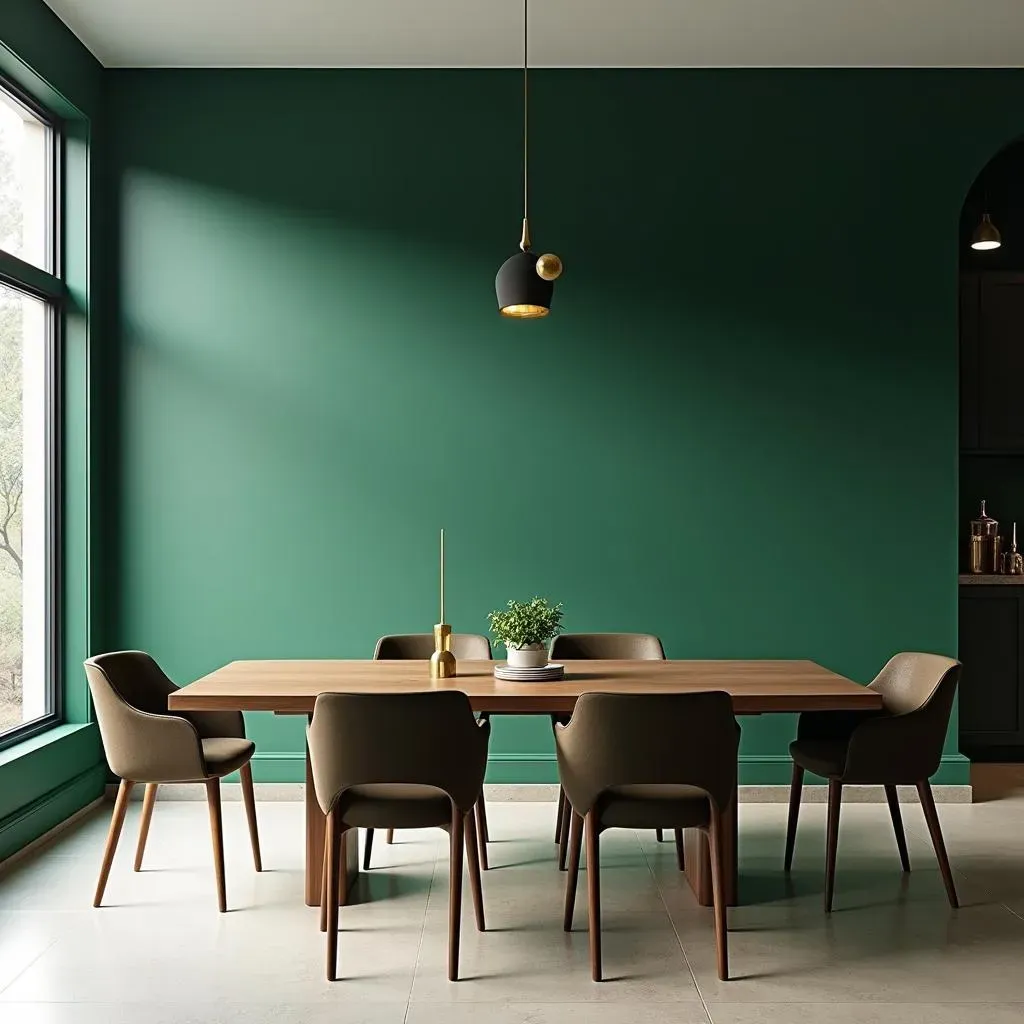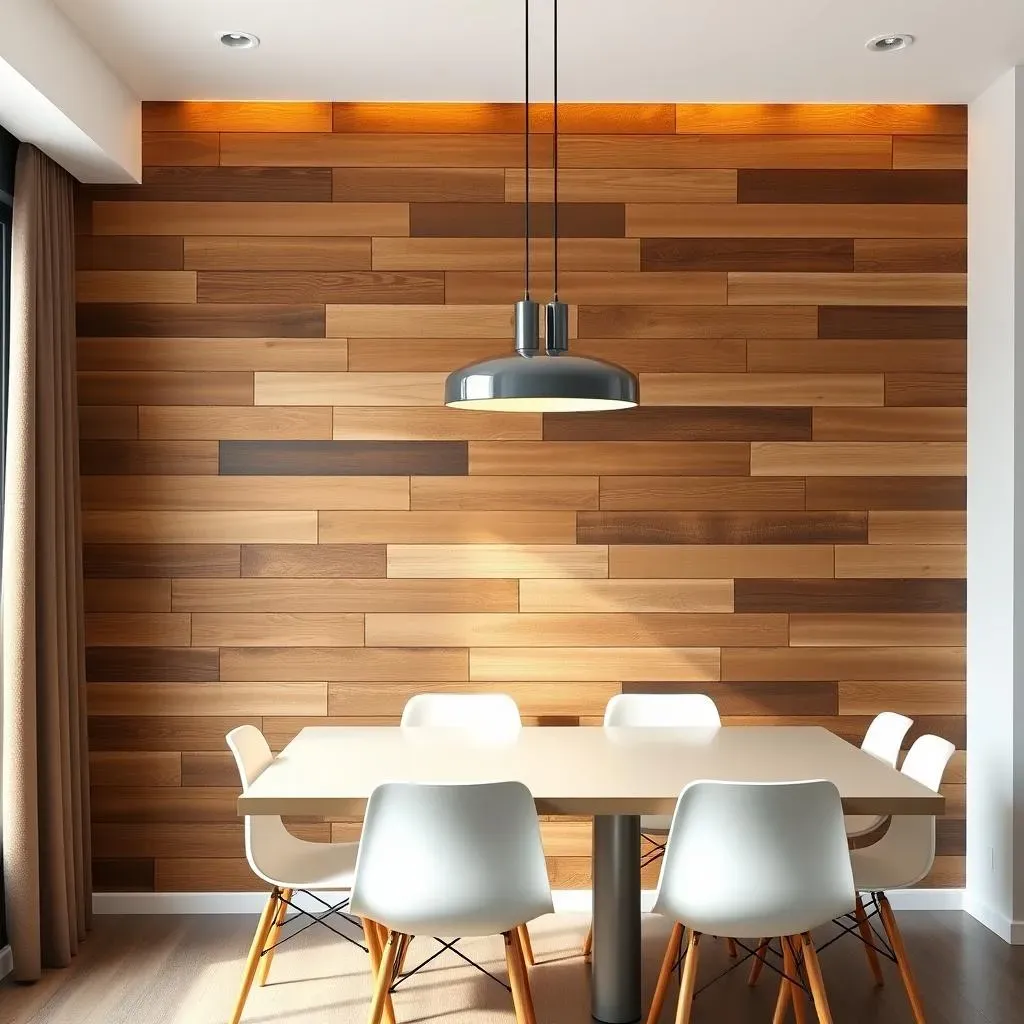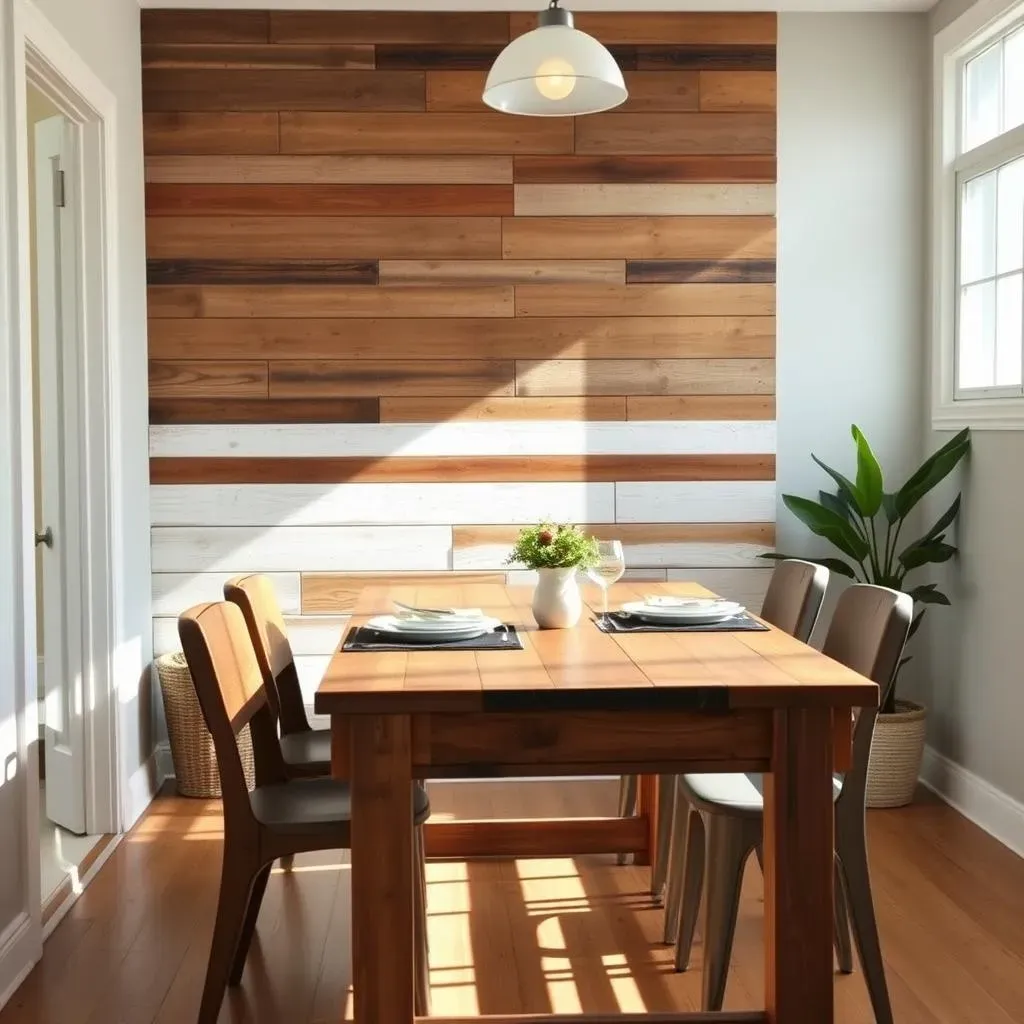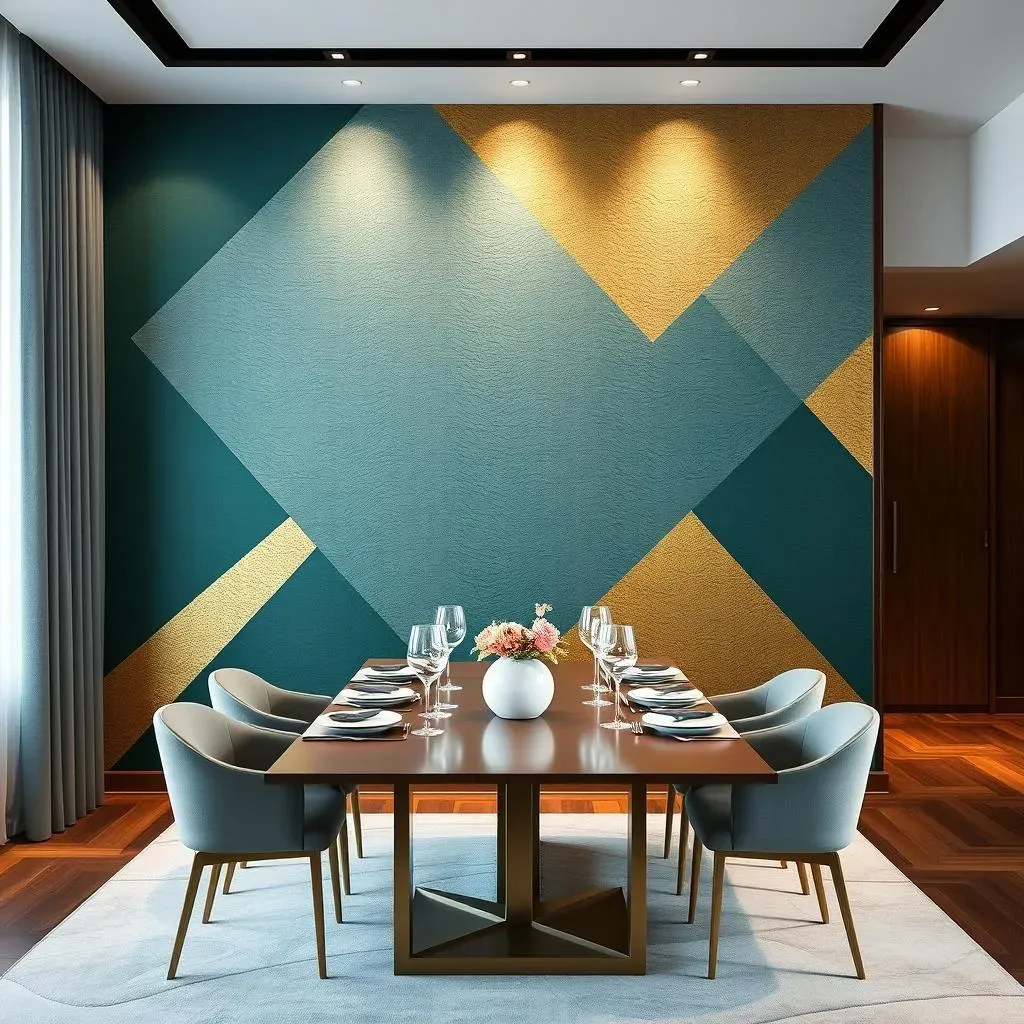Table of Contents
Ready to ditch the dining room doldrums? A carefully chosen accent wall can inject personality, warmth, and a serious dose of style into your eating space. Forget boring beige – we're diving headfirst into a world of dining accent wall ideas that range from the subtly sophisticated to the wildly creative. Whether you're a seasoned DIYer or just starting to explore your inner designer, there's an accent wall solution waiting to transform your dining area from a functional space to a focal point. We'll explore the impact of color, texture, and pattern, offering practical tips and inspiring examples to guide your next home makeover. From bold paint choices and textured wood panels to eye-catching wallpaper and budget-friendly DIY projects, we'll cover all the bases. Get ready to roll up your sleeves and discover how a single wall can completely redefine your dining experience. Let's explore some simple changes to create a room where meals become memories.
Bold & Beautiful: Painted Dining Accent Wall Ideas

Bold & Beautiful: Painted Dining Accent Wall Ideas
let's talk paint! A painted accent wall is the quickest and most dramatic way to transform your dining space. Think of it as instant gratification for your interior design cravings. The beauty of paint lies in its versatility – you can go bold with a saturated jewel tone, create a calming oasis with a muted pastel, or add depth with a dark and moody hue. The key is to consider the existing elements in your dining room: the furniture, flooring, and lighting. You want your accent wall to complement, not clash, with the overall aesthetic.
Before you even crack open a can of paint, grab some swatches and test them out on your wall. Seriously, paint colors can look drastically different in various lighting conditions. Observe how the color shifts throughout the day, and make sure you're still loving it before committing to the entire wall. Don't be afraid to get a little adventurous! A dining room is a great place to experiment with colors you might shy away from in other areas of your home. After all, it's just paint, and you can always change it if you don't love it.
Consider the finish, too. Matte finishes offer a soft, velvety look, while eggshell provides a subtle sheen that's easier to clean. For a truly dramatic effect, consider a high-gloss finish, but be warned: it will highlight any imperfections on the wall, so prep work is essential. Speaking of prep work, don't skimp on it! A smooth, clean surface is crucial for achieving a professional-looking paint job. Fill any holes or cracks, sand down any rough spots, and apply a primer to ensure the paint adheres properly.
And finally, let's not forget about techniques! A simple coat of paint is always a classic choice, but you can also explore more advanced techniques like color blocking, ombre effects, or even faux finishes to add texture and visual interest. The possibilities are endless, so let your creativity run wild! Just remember to have fun and enjoy the process of transforming your dining room with a bold and beautiful painted accent wall.
Color Palette | Effect | Considerations |
|---|---|---|
Jewel Tones (Emerald, Sapphire, Ruby) | Luxurious, Dramatic | Works best in rooms with ample natural light. |
Muted Pastels (Sage Green, Dusty Rose, Sky Blue) | Calming, Serene | Ideal for creating a relaxing dining atmosphere. |
Dark Hues (Charcoal Gray, Navy Blue, Deep Burgundy) | Sophisticated, Intimate | Can make a small room feel smaller; use sparingly. |
Texture & Dimension: Wood and Paneling Dining Accent Wall Ideas

Texture & Dimension: Wood and Paneling Dining Accent Wall Ideas
The Warmth of Wood: Exploring Options
ditch the flat paint for a moment. Let's talk texture! Wood accent walls bring a natural warmth and dimension that paint just can't replicate. We're not just talking about basic wood planks here; there's a whole world of wood options to explore. Think reclaimed wood for a rustic, farmhouse vibe, sleek hardwood panels for a modern touch, or even geometric wood tiles for a truly unique statement. The key is to find a wood type and finish that complements your existing decor and adds the right amount of visual interest.
When selecting wood, consider the grain, color, and texture. Do you want a smooth, uniform look, or do you prefer the character and imperfections of reclaimed wood? Lighter woods like pine and maple can brighten up a space, while darker woods like walnut and mahogany add richness and depth. And don't forget about the finish! A matte finish will enhance the natural texture of the wood, while a glossy finish will add a touch of sophistication. Think about the overall mood you're trying to create in your dining room and choose your wood accordingly.
Wood Type | Style | Pros | Cons |
|---|---|---|---|
Reclaimed Wood | Rustic, Farmhouse | Unique character, eco-friendly | Can be expensive, requires sealing |
Hardwood Panels | Modern, Contemporary | Sleek, easy to install | Can be less visually interesting than other options |
Wood Tiles | Geometric, Eclectic | Adds unique texture and pattern | More challenging to install |
Paneling Perfection: Wainscoting and Beyond
Beyond solid wood, paneling offers another fantastic way to add texture and dimension to your dining room accent wall. Wainscoting, with its classic, timeless appeal, is a popular choice for adding architectural interest. But don't limit yourself to traditional wainscoting! There are tons of modern paneling options available, from shiplap and board and batten to more intricate geometric designs. The best part? Paneling can be painted any color you like, allowing you to customize it to perfectly match your existing decor.
Consider the height of your paneling, too. A lower wainscoting can create a more intimate and cozy feel, while a taller paneling can make a room feel more grand and formal. And don't be afraid to mix and match different types of paneling to create a truly unique look. For example, you could combine shiplap with a chair rail for a coastal-inspired vibe, or use board and batten to create a more modern and geometric feel. The possibilities are endless, so get creative and have fun with it!
Installation Tips and Tricks
you've chosen your wood or paneling – now comes the fun part: installation! Before you start nailing or gluing anything to the wall, make sure you have a clear plan. Measure your wall carefully and mark where each piece of wood or paneling will go. Use a level to ensure everything is straight and even. And don't forget to wear safety glasses and gloves! Depending on the type of wood or paneling you're using, you may need to use a saw, nail gun, or adhesive. If you're not comfortable doing it yourself, don't hesitate to hire a professional.
Also, think about adding some lighting to highlight your beautiful new accent wall. A strategically placed sconce or spotlight can really show off the texture and dimension of the wood or paneling. And finally, don't forget to accessorize! Hang a piece of artwork, add a mirror, or display some decorative objects to complete the look. With a little bit of planning and effort, you can create a wood or paneled accent wall that will transform your dining room into a warm, inviting, and stylish space.
Pattern Play: Wallpaper and Fabric Dining Accent Wall Ideas

Pattern Play: Wallpaper and Fabric Dining Accent Wall Ideas
Wallpaper Wonders: Patterns That Pop
Wallpaper is back in a big way, baby! And it's not your grandma's floral print (unless that's your vibe, then rock it!). We're talking bold geometrics, intricate damasks, playful tropical prints, and even realistic murals that can transport you to another world. Wallpaper is an easy way to inject personality and visual interest into your dining room without having to commit to a full-on renovation. The key is to choose a pattern that complements your existing furniture and decor, and that reflects your personal style.
When selecting wallpaper, consider the scale of the pattern. A large-scale pattern can make a small room feel even smaller, while a small-scale pattern can get lost in a larger space. Also, think about the color palette. Do you want a bold and vibrant pattern that makes a statement, or a more subtle and muted pattern that blends in with the background? And don't forget about texture! Embossed wallpapers, grasscloth wallpapers, and even textured paintable wallpapers can add depth and dimension to your walls.
Pro Tip: If you're feeling intimidated by the thought of wallpapering an entire wall, start with a smaller area, like a niche or alcove. Or, consider using removable wallpaper, which is a great option for renters or anyone who likes to change things up frequently. With removable wallpaper, you can experiment with different patterns and colors without having to commit to anything permanent.
Fabric Flair: Softness and Texture
Who says walls are just for paint and paper? Fabric can add a touch of softness and luxury to your dining room accent wall. We're not just talking about hanging a tapestry here (although that can be cool, too!). You can actually upholster your walls with fabric to create a truly unique and tactile experience. Imagine sinking into a cozy booth surrounded by plush velvet or linen walls – talk about a dining experience!
Upholstering a wall may sound intimidating, but it's actually a relatively simple DIY project. All you need is some fabric, batting, a staple gun, and a little bit of patience. Choose a fabric that's durable and easy to clean, and that complements your existing decor. Linen, velvet, and even outdoor fabrics are great options. And don't be afraid to experiment with different textures and patterns. A tufted fabric wall can add a touch of glamour, while a quilted fabric wall can create a cozy and inviting feel.
Fabric Type | Style | Pros | Cons |
|---|---|---|---|
Linen | Casual, Relaxed | Breathable, Durable | Can wrinkle easily |
Velvet | Luxurious, Glamorous | Soft, Adds depth | Can be difficult to clean |
Outdoor Fabric | Durable, Practical | Water-resistant, Easy to clean | Can lack visual interest |
Mixing and Matching: Creating a Unique Look
the rules! Who says you have to choose between wallpaper and fabric? Why not combine them to create a truly unique and personalized dining room accent wall? Imagine a wallpapered wall with a fabric-covered headboard or bench seat. Or, a fabric-paneled wall with a wallpaper border. The possibilities are endless!
The key to mixing and matching patterns is to find a common thread that ties them together. This could be a color, a texture, or a theme. For example, you could pair a floral wallpaper with a solid-colored fabric in a complementary hue. Or, you could combine a geometric wallpaper with a textured fabric in a similar scale. And don't be afraid to add in other elements, like artwork, mirrors, or lighting, to complete the look. With a little bit of creativity and experimentation, you can create a dining room accent wall that's as unique and stylish as you are.
DIY Dining Accent Wall Ideas: BudgetFriendly Transformations

DIY Dining Accent Wall Ideas: BudgetFriendly Transformations
Repurpose and Reimagine: Creative Upcycling
Alright, let's talk about making magic without breaking the bank! DIY doesn't have to mean complicated or expensive. In fact, some of the most stunning accent walls come from creative upcycling. Think about it: that pile of old pallets in your backyard? Accent wall gold! Those vintage book pages you've been hoarding? Instant conversation starter! The key is to look around your home and see what you can repurpose into a unique and eye-catching feature.
Old doors can be sanded, painted, and mounted to create a rustic, farmhouse-chic accent wall. Wine corks can be glued together to form a textured, eco-friendly masterpiece. Even paint sticks can be arranged in geometric patterns for a modern and minimalist vibe. Don't be afraid to get a little unconventional and think outside the box. The more creative you are, the more personal and unique your DIY accent wall will be.
Faux Finishes and Clever Illusions
so maybe you don't have a stash of reclaimed wood or vintage wallpaper lying around. No problem! You can still achieve a high-end look on a budget with faux finishes and clever illusions. Faux brick panels can instantly add an industrial-chic vibe to your dining room without the cost or hassle of real brick. Peel-and-stick wallpaper is a renter-friendly way to experiment with different patterns and textures without committing to anything permanent. And even a simple paint treatment, like a sponge-painted texture or a stenciled design, can add depth and visual interest to your walls.
Consider using painter's tape to create geometric patterns or stripes. This is a super affordable and easy way to add a modern touch to your dining room. Or, try a faux shiplap effect by painting vertical lines on your wall. The key is to be creative and resourceful. With a little bit of imagination and some elbow grease, you can create a stunning DIY accent wall that looks like it cost a fortune, but really only cost you a few bucks and some time.
DIY Idea | Materials Needed | Estimated Cost |
|---|---|---|
Pallet Wood Wall | Pallets, Sandpaper, Paint/Stain, Nails/Screws | $20-$50 |
Book Page Wall | Old Books, Mod Podge, Brush | $10-$30 |
Painter's Tape Geometric Design | Painter's Tape, Paint, Brushes | $15-$40 |
Conclusion: Your Dining Accent Wall, Your Style
So, you've journeyed through a spectrum of dining accent wall ideas, from the timeless elegance of wood paneling to the vibrant statements made with bold colors and patterns. Remember, the best accent wall is one that reflects your personal style and enhances the overall ambiance of your dining space. Don't be afraid to experiment, mix and match textures, and let your creativity shine. Whether you choose a simple DIY project or a more elaborate design, a well-executed dining accent wall can transform your room into a welcoming and stylish haven for meals and memories.
